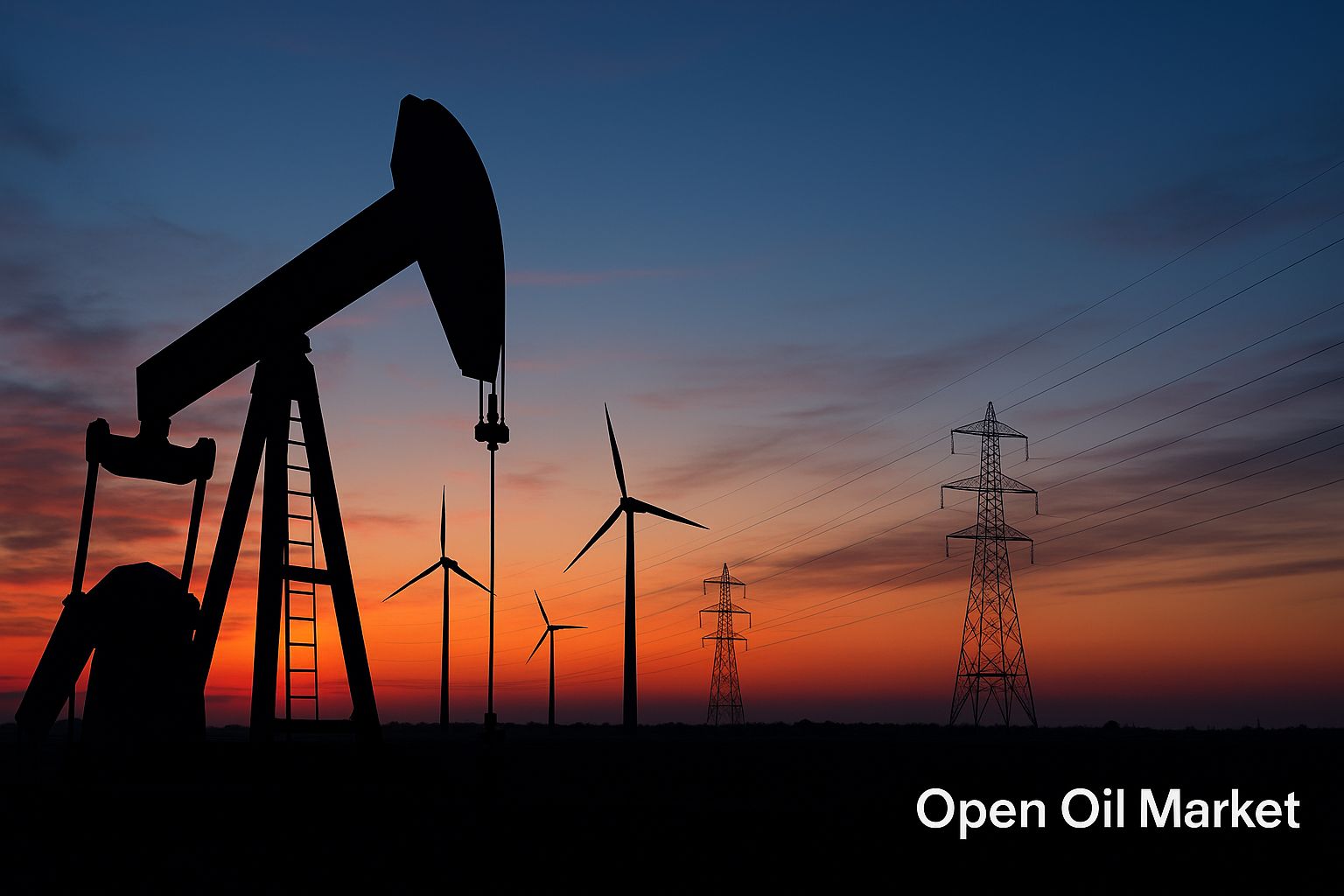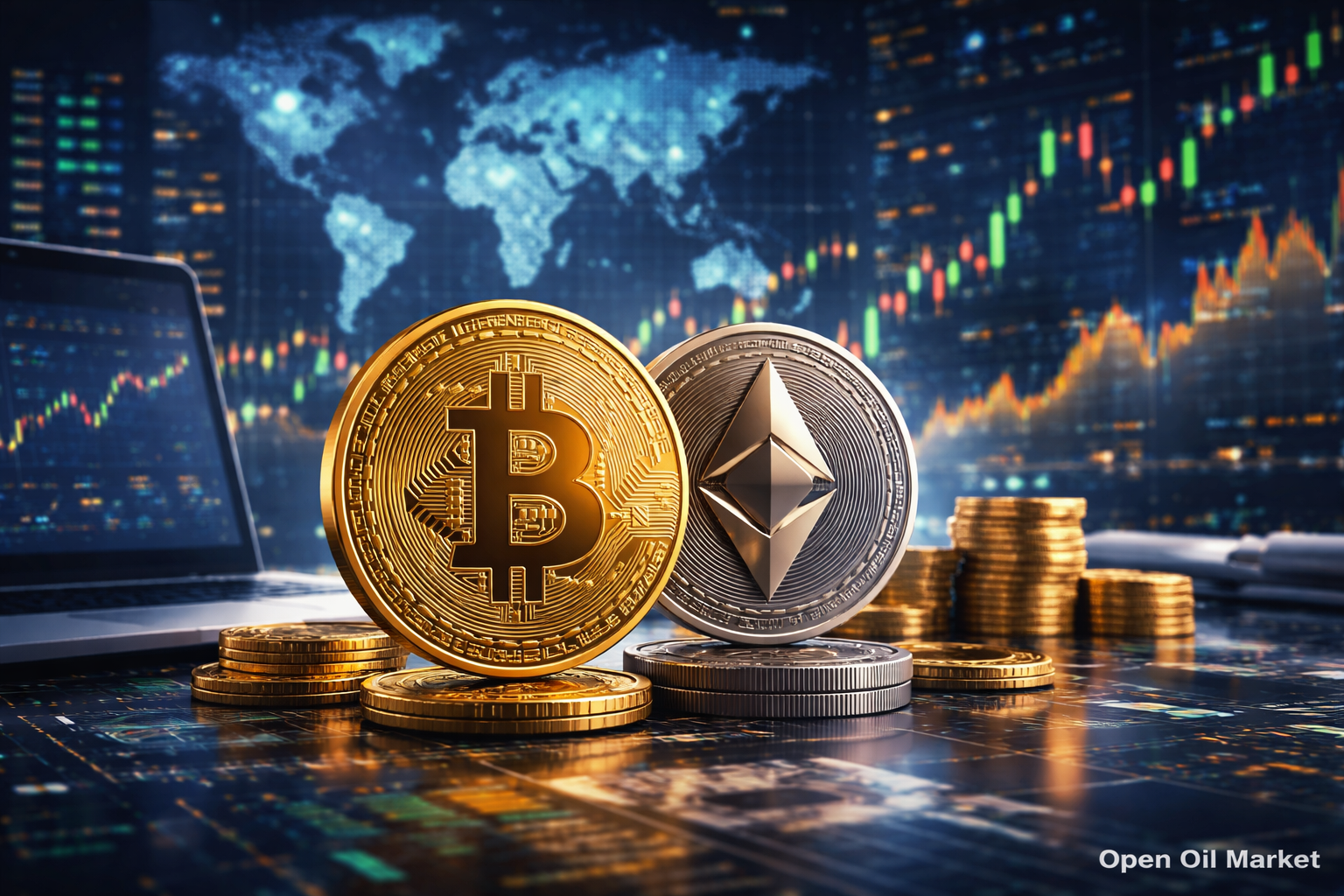
Current Energy Sector News for Tuesday, October 14, 2025: Pressure on Oil Market, Stability in Gas Market, Increased Sanction Pressure, Investment Boom in Renewables, and Launch of the Energy Forum. Analytics by Open Oil Market.
By mid-October 2025, the global energy sector is facing a contradictory backdrop. Oil prices are under pressure from expectations of oversupply and some geopolitical easing (after de-escalation in the Middle East), while the confrontation between Russia and the West remains severe: sanctions against the Russian energy sector are expanding, and a peaceful resolution to the conflict in Ukraine is still out of reach.
The European gas market is entering winter calmly with record reserves, keeping prices stable. The global energy transition is accelerating amid record investments in renewable energy. In Russia, government measures (extension of export restrictions and others) are already yielding initial results in stabilizing gasoline and diesel supply. The upcoming "Russian Energy Week 2025" forum in Moscow is at the center of the industry’s attention, where the next steps for energy development under new conditions will be discussed. Below is an overview of key events and trends in the industry as of October 14, 2025, which are significant for investors and stakeholders in the energy sector.
Fuel Market Stabilization in Russia: Government Measures and Initial Results
Following the peak fuel crisis in September, the situation in the domestic gasoline and diesel market is gradually stabilizing. The Russian government has managed to curb the panic and stabilize wholesale prices for petroleum products through a range of emergency measures:
- Export restrictions: the temporary ban on gasoline exports has been extended until the end of 2025; a partial ban on diesel fuel exports is also maintained. These measures are aimed at redirecting maximum fuel volumes to the domestic market.
- Moratorium on dampening: a temporary moratorium on the zeroing of the fuel damping has been introduced since October 1. The state will continue to pay refiners compensation for supplies to the domestic market, even if market prices exceed indicative levels. This step maintains the economic motivation to supply Russian gas stations with the necessary volumes of gasoline and diesel, while the Federal Antimonopoly Service is closely monitoring retail prices.
The initial results of these measures are already visible. As oil refineries return to operation after unscheduled repairs and export volumes shift to the domestic market, the deficit of motor fuel is beginning to shrink. In early October, supplies of gasoline and diesel to the wholesale market increased, allowing gas stations in affected regions to gradually replenish their stocks. The situation is normalizing in central Russia, although supply remains tense in the Far East and certain Siberian regions, requiring constant monitoring. The government hopes that the combination of adopted measures will allow for a winter period without sharp supply disruptions. Meanwhile, the Ministry of Finance warns that the introduction of new taxes on oil workers could lead to a new round of fuel shortages.
Oil Market: Oversupply Pressures Prices, Sanction Risks Persist
Global oil prices in early October remain under bearish pressure after a brief rise the previous month. OPEC+'s decision at its meeting on October 5 confirmed a cautious approach to increasing production, which heightened expectations of an oversupply by the end of the year. Benchmark Brent crude is holding around $62-64 per barrel, while U.S. WTI has dropped to ~$58 — significantly below the yearly highs (around $80 in the spring). The oil market is currently pricing in an oversupply scenario: prices are now 15-20% lower than peak values, reflecting concerns about overproduction and slowing demand.
- Supply and demand: OPEC+ at its meeting on October 5 agreed to a slight increase in production (~+140,000 barrels/day from November), signaling cautious increment. However, many alliance members are close to maximum capacities, thus the actual increase in supply will be limited. By the end of 2025, a surplus of oil is expected: economic growth in Europe and China is slowing, while output outside OPEC (especially in the U.S.) is rising. Current prices are 15-20% below spring peaks, and market pressure may persist until early 2026 under the oversupply scenario.
- Sanctions and geopolitics: the intensification of Western sanctions against the Russian energy sector generates additional uncertainties. Mid-year, the EU imposed another package of restrictions, lowering the price cap on Russian oil to below $50 per barrel, and new measures are currently under discussion. Washington is urging allies to completely abandon Russian energy resources and to crack down hard on sanction avoidance schemes (including the use of 'dark fleet’ tankers). Any further tightening of the sanction regime could reduce the available market supply and unexpectedly change the price trend upwards. Moreover, conflicts in the Middle East and Eastern Europe continue to pose risks of oil supply disruptions, thus the geopolitical premium has not completely disappeared.
- Russian exports: despite unprecedented sanctions, Russia has redirected its main oil flows to Asia (primarily to China and India), allowing it to maintain a high level of exports. However, further tightening of the sanction regime (for instance, secondary restrictions) could narrow these alternative sales channels and strike a blow to the Russian oil industry.
Natural Gas: Record Stocks in the EU and Eastern Export Shift
The natural gas market is stable as it approaches the winter season. The European Union has approached mid-October with gas storages at record levels — averaging over 95% of maximum storage capacity, significantly higher than last year’s levels. Wholesale gas prices in Europe remain relatively low: the TTF market index fluctuates between €30-35/MWh, significantly lower than the peaks in autumn 2022. High stocks and moderate demand provide a safety cushion, ensuring a relatively calm situation in the gas market.
- Full storages and LNG: favorable weather and conservation measures in summer allowed the EU to fill gas storages to nearly maximum levels without urgent purchases. Significant volumes of liquefied natural gas (LNG) were redirected to Europe amid declining demand in Asia, compensating for the reduction in pipeline supplies from Russia. As a result, Europe’s energy security ahead of winter has become more robust – even in case of colder weather, reserves will be sufficient to avoid sharp price surges.
- Rejection of Russian gas: European countries have minimized their dependence on Russian fuel. Direct supplies of Russian pipeline gas have fallen to negligible levels, and Russia's share in the EU gas imports is now below 15% and continues to decline. A complete rejection of supplies from Russia is expected in the coming years – this step will deprive Gazprom of a key market but will stimulate Europe to more rapidly develop alternative sources and infrastructure (LNG terminals, new pipelines, etc.).
- Russia's Eastern Shift: having lost a significant portion of the European market, Moscow is redirecting gas exports to the East. Supplies via the "Power of Siberia" pipeline to China continue to grow and may exceed 22 billion cubic meters in 2025 – a record since the launch. Negotiations are also underway to build the "Power of Siberia-2" pipeline through Mongolia, which by the end of the decade will partially compensate for the lost European volumes. Additionally, Russia is increasing LNG exports and expanding cooperation with friendly Asian countries. This "Eastern shift" is reducing the Russian gas sector's dependence on the European direction.
Renewable Energy: Investment Boom and Growing Share of Green Energy
The renewable energy sector in 2025 continues to demonstrate rapid growth, confirming the global trend toward the "green" transformation of the energy sector. Investments in solar and wind power are reaching historic highs. In the first six months of 2025 alone, approximately $400 billion was invested worldwide in renewable energy projects. These funds are primarily directed toward the construction of new solar and wind power plants, energy storage systems, and grid modernization. Large-scale projects are being commissioned, allowing electricity generation to increase without rising greenhouse gas emissions.
- Growing share and support: the share of renewable energy in global electricity generation has approached 30% (exceeding 45% in the EU). Governments of leading economies have increased support for "green" energy: new climate goals in the EU accelerate the introduction of clean capacity, in the U.S., significant subsidy and tax incentive programs are in place for renewable investors, and initiatives to develop solar and wind farms are being launched in several CIS countries. These measures are stimulating further investment inflow into clean energy.
Geopolitics: Sanction Standoff and Conflicts Define the Rules of the Game
The geopolitical situation remains one of the main factors influencing energy sector markets. An armed conflict between Russia and Ukraine continues in Eastern Europe without significant progress in negotiations. Ukraine's energy infrastructure is regularly subjected to attacks, highlighting the vulnerability of the sector in the conflict zone. Meanwhile, relations between Russia and Western countries are extremely strained. The sanction standoff shows no signs of weakening — on the contrary, the EU, the U.S., and their partners regularly adopt new sanction packages aimed at reducing Russia's export revenues and limiting access to technologies. The Russian energy sector is forced to adapt to operate under isolation, reconfiguring supply logistics and attracting alternative partners for project financing. There are no hopes for easing the sanctions regime in the foreseeable future.
Additional uncertainty is generated by trade disputes among the largest economies. The confrontation between the U.S. and China is escalating: Washington threatens new tariffs, while Beijing prepares retaliatory measures. The risk of escalation of the trade war between the two superpowers increases concerns about the prospects for the global economy and may reduce future demand for energy resources. At the same time, diplomatic efforts have led to a thaw in the Middle East. A truce in one of the regional conflicts (in the Middle East) has temporarily reduced risks for the oil market. However, the situation in the region remains unstable: any new escalation could quickly restore the geopolitical premium on the market.
Forecasts and Expectations: Energy Forum and Winter Risks
Overall, the energy sector is approaching the end of 2025 in a state of adaptation to new realities. The sanction standoff between Russia and the West continues to reshape global trade in energy resources. Energy companies are seeking ways to mitigate risks and explore new niches — whether that be redirecting exports to Asian markets or increasing deep processing of raw materials domestically. Concurrently, the global energy transition is gaining momentum: record investments in renewable energy and energy conservation are shaping the long-term configuration of the sector. The coming months will show how successfully the industry can navigate winter challenges and balance interests in this complex year of 2025.




